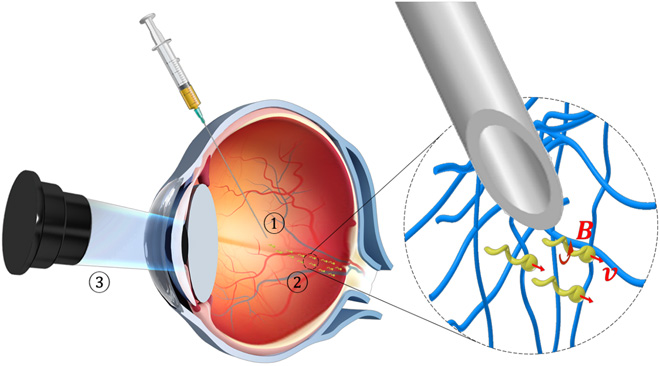
Nanobots heading to eye delivery
German researchers have developed a drug delivery nanobot that can propel through the eye.
Traditional methods of intravitreal delivery of therapeutic agents rely on the random, passive diffusion of molecules, which do not allow for the rapid delivery of a concentrated cargo to a defined region at the posterior pole of the eye. The use of particles promises targeted delivery but the tight macromolecular matrix of the vitreous compartment acts as a barrier and prevents its penetration. So far, the transport of nano-vehicles has only been demonstrated in model systems or biological fluids, but not in real tissue
Researchers at Max-Planck-Institut for Intelligent Systems have now presented novel intravitreal delivery microvehicles called slippery micropropellers that can be actively propelled through the vitreous humor to reach the retina (Science Advances). The propulsion of the micropropellers, which are are only 500 nm wide – exactly small enough to fit through the tight molecular matrix of the gel-like substance in the vitreous – is achieved by helical micropropellers. The nanodevices can be moved in a magnetic field and that have a liquid layer coating to minimise adhesion to the surrounding biopolymeric network. The submicrometer diameter of the propellers enables the penetration of the biopolymeric network and the propulsion through the porcine vitreous body of the eye over centimeter distances.
Optical coherence tomography analyses conducted at the Eye Hospital of the University of Tübingen to monitor the movement of the propellers confirmed their arrival on the retina near the optic disc. Overcoming the adhesion forces and actively navigating a swarm of micropropellers in the dense vitreous humor is one step further towards nanorobots becoming minimally-invasive tools for precisely delivering medicine to where it is needed.
The principle of the propulsion of the nanorobots, their small size, as well as the slippery coating, will be useful, not only in the eye, but for the penetration of a variety of tissues in the human body, says group leader Tian Qiuat the MPI-IS in Stuttgart, Germany. We want to be able to use our nanopropellers as tools in the minimally-invasive treatment of all kinds of diseases, where the problematic area is hard to reach and surrounded by dense tissue. Not too far in the future, we will be able to load them with drugs.


 BIOCOM / aminul788 - Adobe Stock
BIOCOM / aminul788 - Adobe Stock Bayer Co.Lab
Bayer Co.Lab